最全英语倒装句讲解和练习附答案
- 格式:doc
- 大小:95.00 KB
- 文档页数:13
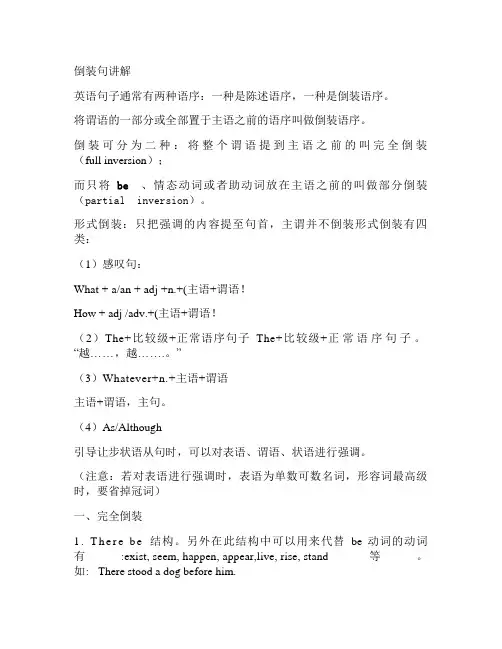
倒装句讲解英语句子通常有两种语序:一种是陈述语序,一种是倒装语序。
将谓语的一部分或全部置于主语之前的语序叫做倒装语序。
倒装可分为二种:将整个谓语提到主语之前的叫完全倒装(full inversion);而只将be 、情态动词或者助动词放在主语之前的叫做部分倒装(partial inversion)。
形式倒装:只把强调的内容提至句首,主谓并不倒装形式倒装有四类:(1)感叹句:What + a/an + adj +n.+(主语+谓语!How + adj /adv.+(主语+谓语!(2)The+比较级+正常语序句子The+比较级+正常语序句子。
“越……,越…….。
”(3)Whatever+n.+主语+谓语主语+谓语,主句。
(4)As/Although引导让步状语从句时,可以对表语、谓语、状语进行强调。
(注意:若对表语进行强调时,表语为单数可数名词,形容词最高级时,要省掉冠词)一、完全倒装1.T h e r e b e结构。
另外在此结构中可以用来代替be动词的动词有:exist, seem, happen, appear,live, rise, stand等。
如: There stood a dog before him.There exist different opinions on this question.2 (1.在以here、there、n o w、then等副词开头的句子里。
“Here, There, Now, Then + come (或be,go,lie,run + 主语"结构。
Here comes the old lady!Then came the hour we had been looking forward to.There comes the bus.Now comes your turn.如果主语是人称代词,就不用倒装。
如:Here you are.There she comes.(2.表示方向的副词out, in, up, down等置于句首,要用全部倒装。
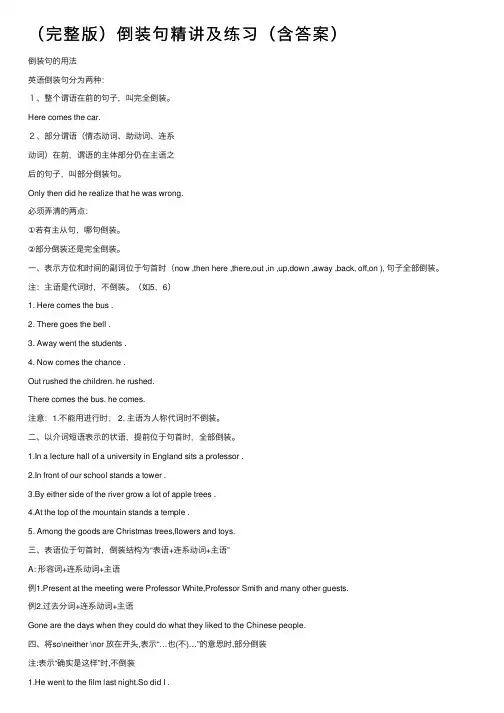
(完整版)倒装句精讲及练习(含答案)倒装句的⽤法英语倒装句分为两种:1、整个谓语在前的句⼦,叫完全倒装。
Here comes the car.2、部分谓语(情态动词、助动词、连系动词)在前,谓语的主体部分仍在主语之后的句⼦,叫部分倒装句。
Only then did he realize that he was wrong.必须弄清的两点:①若有主从句,哪句倒装。
②部分倒装还是完全倒装。
⼀、表⽰⽅位和时间的副词位于句⾸时(now ,then here ,there,out ,in ,up,down ,away ,back, off,on ), 句⼦全部倒装。
注:主语是代词时,不倒装。
(如5,6)1. Here comes the bus .2. There goes the bell .3. Away went the students .4. Now comes the chance .Out rushed the children. he rushed.There comes the bus. he comes.注意:1.不能⽤进⾏时; 2. 主语为⼈称代词时不倒装。
⼆、以介词短语表⽰的状语,提前位于句⾸时,全部倒装。
1.In a lecture hall of a university in England sits a professor .2.In front of our school stands a tower .3.By either side of the river grow a lot of apple trees .4.At the top of the mountain stands a temple .5. Among the goods are Christmas trees,flowers and toys.三、表语位于句⾸时,倒装结构为“表语+连系动词+主语”A: 形容词+连系动词+主语例1.Present at the meeting were Professor White,Professor Smith and many other guests.例2.过去分词+连系动词+主语Gone are the days when they could do what they liked to the Chinese people.四、将so\neither \nor 放在开头,表⽰“…也(不)…”的意思时,部分倒装注:表⽰“确实是这样”时,不倒装1.He went to the film last night.So did I .2.You must finish your work ,so must I .3.She is interested in the story ,so am I .4.He didn’t turn up .Neither did his brother .5.His mother told him not to go to the film .So he did.五、在if 条件句中,通常可以省略if ,⽽将从句倒装条件:在if 条件句,必须含有系动词were, 助动词had 和情态动词should1.Were he younger(=If he were younger ),he would learn skating .2.Should they forget (=If they should forget ) to bring a map with them ,they would get lost in the woods .3.Had they realized (=If they had realized ) how important the task was ,they wouldn’t have refused to accept .4.Were I you ,I would help her .六、否定词或半否定词(never .little ,seldom ,not ,nowhere ,scarely ,few ,by no means ,at no time )位于句⾸,应部分倒装1.Never have I been there .2.Little did I know about it .3.Seldom did she come late to school .4.Not a single mistake did he make .5.By no means should you buy that kind of car .七、以not until ,no sooner …than , hardly …when ,not only …but also 所引导的状语放在句⾸时,需要部分倒装1.Not until 10’clock will the library open .2.No sooner had I gone out than he came to see me .3.Hardly had the train arrived when I ran to meet my friend.4.Not only does she speak English but also she follows the British way of life .⼋、only 及其修饰的状语位于句⾸时,后⾯的句⼦部分倒装。
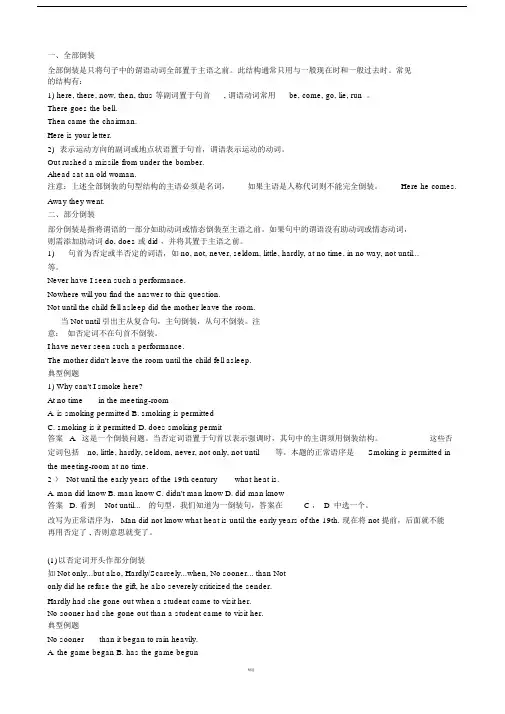
一、全部倒装全部倒装是只将句子中的谓语动词全部置于主语之前。
此结构通常只用与一般现在时和一般过去时。
常见的结构有:1) here, there, now, then, thus 等副词置于句首, 谓语动词常用be, come, go, lie, run 。
There goes the bell.Then came the chairman.Here is your letter.2)表示运动方向的副词或地点状语置于句首,谓语表示运动的动词。
Out rushed a missile from under the bomber.Ahead sat an old woman.注意:上述全部倒装的句型结构的主语必须是名词,如果主语是人称代词则不能完全倒装。
Here he comes. Away they went.二、部分倒装部分倒装是指将谓语的一部分如助动词或情态倒装至主语之前。
如果句中的谓语没有助动词或情态动词,则需添加助动词 do, does 或 did ,并将其置于主语之前。
1)句首为否定或半否定的词语,如no, not, never, seldom, little, hardly, at no time, in no way, not until...等。
Never have I seen such a performance.Nowhere will you find the answer to this question.Not until the child fell asleep did the mother leave the room.当 Not until 引出主从复合句,主句倒装,从句不倒装。
注意:如否定词不在句首不倒装。
I have never seen such a performance.The mother didn't leave the room until the child fell asleep.典型例题1) Why can't I smoke here?At no time___ in the meeting-roomA. is smoking permittedB. smoking is permittedC. smoking is it permittedD. does smoking permit答案 A. 这是一个倒装问题。
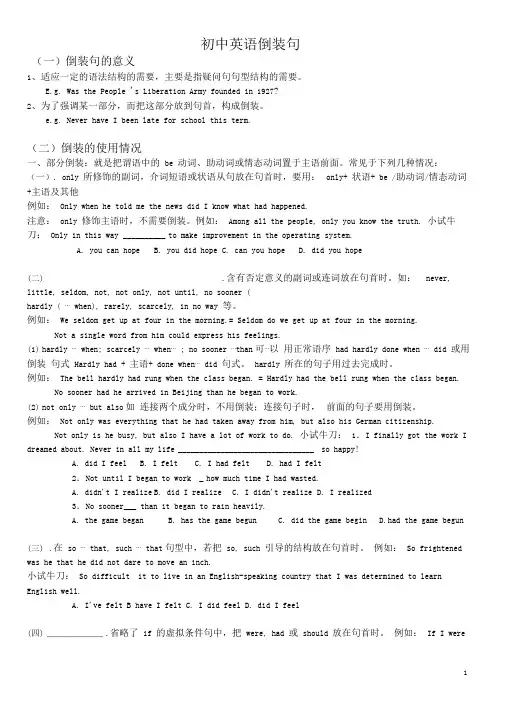
初中英语倒装句(一)倒装句的意义1、适应一定的语法结构的需要,主要是指疑问句句型结构的需要。
E.g. Was the People 's Liberation Army founded in 1927?2、为了强调某一部分,而把这部分放到句首,构成倒装。
e.g. Never have I been late for school this term.(二)倒装的使用情况一、部分倒装:就是把谓语中的be 动词、助动词或情态动词置于主语前面。
常见于下列几种情况:(一). only 所修饰的副词,介词短语或状语从句放在句首时,要用:only+ 状语+ be /助动词/情态动词+主语及其他例如:Only when he told me the news did I know what had happened.注意:only 修饰主语时,不需要倒装。
例如:Among all the people, only you know the truth. 小试牛刀:Only in this way __________ to make improvement in the operating system.A.you can hopeB. you did hopeC. can you hopeD. did you hope(二).含有否定意义的副词或连词放在句首时。
如:never, little, seldom, not, not only, not until, no sooner (hardly ( ⋯when), rarely, scarcely, in no way 等。
例如:We seldom get up at four in the morning.= Seldom do we get up at four in the morning.Not a single word from him could express his feelings.(1)hardly ⋯when; scarcely ⋯when⋯; no sooner ⋯than可⋯以用正常语序had hardly done when ⋯did 或用倒装句式Hardly had + 主语+ done when⋯did 句式。
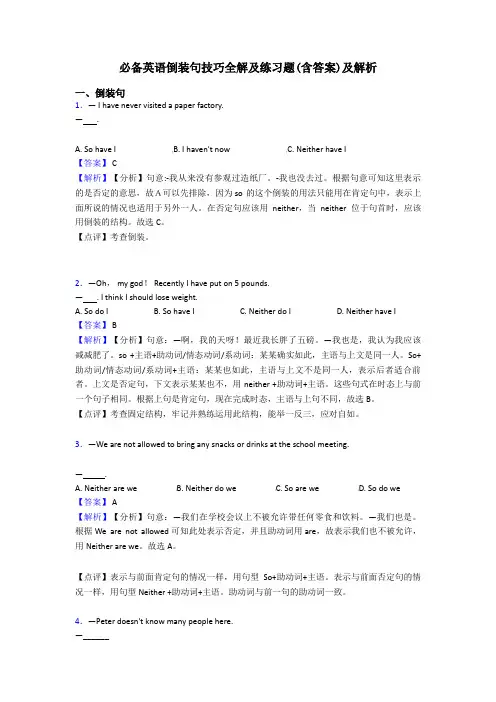
必备英语倒装句技巧全解及练习题(含答案)及解析一、倒装句1.— I have never visited a paper factory.— .A. So have IB. I haven't nowC. Neither have I【答案】 C【解析】【分析】句意:-我从来没有参观过造纸厂。
-我也没去过。
根据句意可知这里表示的是否定的意思,故A可以先排除,因为so 的这个倒装的用法只能用在肯定句中,表示上面所说的情况也适用于另外一人。
在否定句应该用neither,当neither 位于句首时,应该用倒装的结构。
故选C。
【点评】考查倒装。
2.—Oh, my god! Recently I have put on 5 pounds.— . I think I should lose weight.A. So do IB. So have IC. Neither do ID. Neither have I【答案】 B【解析】【分析】句意:—啊,我的天呀!最近我长胖了五磅。
—我也是,我认为我应该减减肥了。
so +主语+助动词/情态动词/系动词:某某确实如此,主语与上文是同一人。
So+助动词/情态动词/系动词+主语:某某也如此,主语与上文不是同一人,表示后者适合前者。
上文是否定句,下文表示某某也不,用 neither +助动词+主语。
这些句式在时态上与前一个句子相同。
根据上句是肯定句,现在完成时态,主语与上句不同,故选B。
【点评】考查固定结构,牢记并熟练运用此结构,能举一反三,应对自如。
3.—We are not allowed to bring any snacks or drinks at the school meeting.— .A. Neither are weB. Neither do weC. So are weD. So do we【答案】 A【解析】【分析】句意:—我们在学校会议上不被允许带任何零食和饮料。
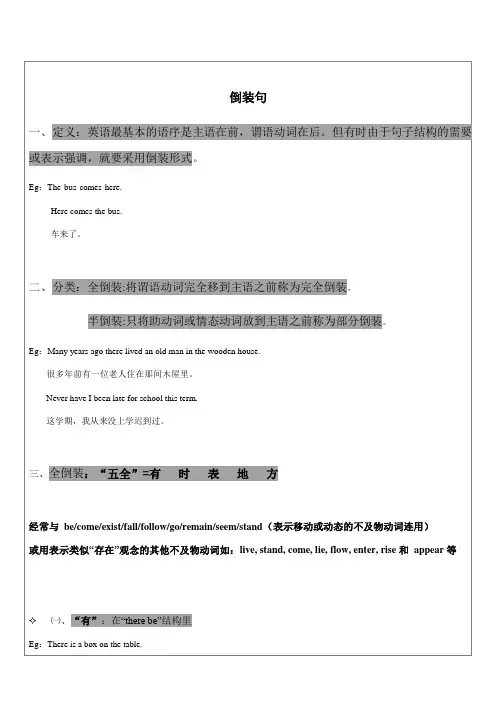
桌子上面有一个盒子。
✧㈡、“时”:表示时间副词,如:now,then,
Eg:Now comes your turn.
现在轮到你了。
✧㈢、“表”:表语放句子前,“表语+系动词+主语” 的结构
Eg:Present at the party were Mr. Green and many other guests.
格林先生和其他的客人在这个聚会上。
Seated on the ground are a group of young men.
一群年轻人坐在了地上。
✧㈣、“地”:地点状语放在句首
Eg:In south of the river lies a small factory.
小工厂位于河的南方。
From the valley came a cry.
山谷传来一阵哭声。
✧㈤、“方”:表方位的副词here, there 或out, in, up, down, away, off 等标志词放在句首 Eg:There lies a large wheat field in front of the house.
房子前面有一大片麦田。
Off all the lights went when I came in.
当我进来时,所有的灯都灭了。
四、半倒装:“八部”=不只让步也常需(虚)如此祝福✧㈠、“不”表示否定。
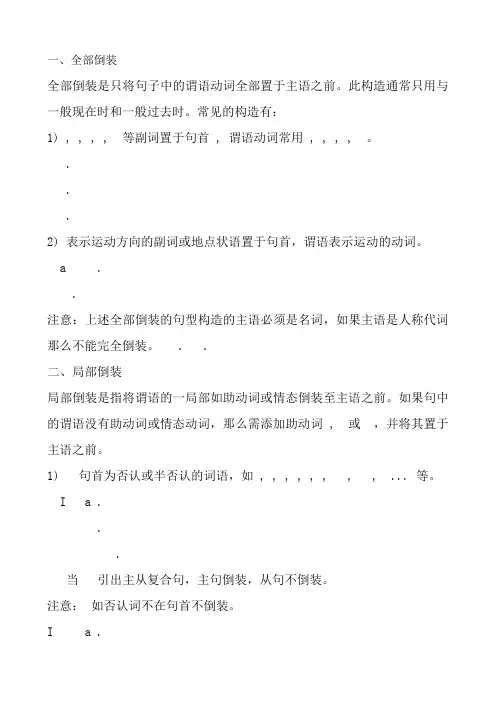
一、全部倒装全部倒装是只将句子中的谓语动词全部置于主语之前。
此构造通常只用与一般现在时和一般过去时。
常见的构造有:1) , , , , 等副词置于句首 , 谓语动词常用 , , , , 。
...2) 表示运动方向的副词或地点状语置于句首,谓语表示运动的动词。
a ..注意:上述全部倒装的句型构造的主语必须是名词,如果主语是人称代词那么不能完全倒装。
. .二、局部倒装局部倒装是指将谓语的一局部如助动词或情态倒装至主语之前。
如果句中的谓语没有助动词或情态动词,那么需添加助动词 , 或,并将其置于主语之前。
1) 句首为否认或半否认的词语,如 , , , , , , , , ... 等。
I a ...当引出主从复合句,主句倒装,从句不倒装。
注意:如否认词不在句首不倒装。
I a .典型例题1) 't I ?A. B.C. D.答案 A. 这是一个倒装问题。
当否认词语置于句首以表示强调时,其句中的主谓须用倒装构造。
这些否认词包括 , , , , , , 等。
此题的正常语序是 .2 〕 19 .A. B. C. 't D.答案 D. 看到 ... 的句型,我们知道为一倒装句,答案在 C , D 中选一个。
改写为正常语序为, 19. 现在将提前,后面就不能再用否认了 , 否那么意思就变了。
(1)以否认词开头作局部倒装如 , , ..., .a .a .典型例题.C. D.答案 D. 以具有否认意义的副词放在句首时,一般采用倒装句 ( 谓语前置 ) 。
这类表示否认意义的词有 , , , , , , , 以及 (), , ... ... 等等。
注意:只有当 ... 连接两个分句时,才在第一个分句用倒装构造。
如果置于句首的 ... 仅连接两个并列词语,不可用倒装构造。
I .(2), , 作局部倒装表示 " 也 " 、 " 也不 " 的句子要局部倒装。
. .'t , I.典型例题?'t , .A. 't IB. IC. I 'tD. I 't答案: B. 为增补意思 " 也不关心 " ,因此句子应倒装。
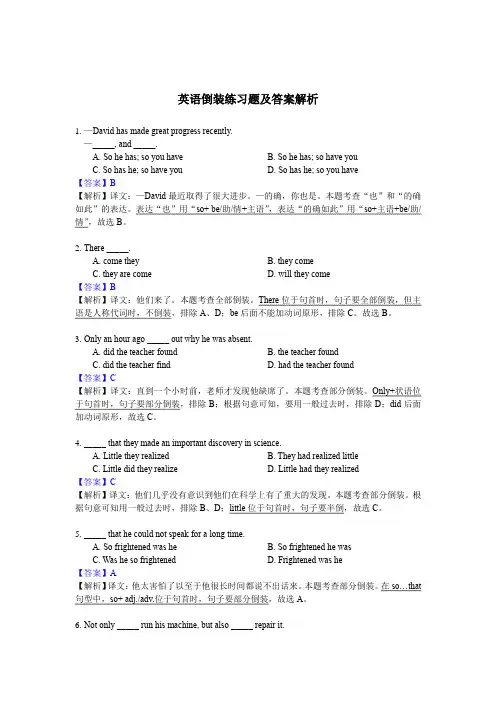
英语倒装练习题及答案解析1.—David has made great progress recently.—_____, and _____.A. So he has; so you haveB. So he has; so have youC. So has he; so have youD. So has he; so you have【答案】B【解析】译文:—David最近取得了很大进步。
—的确,你也是。
本题考查“也”和“的确如此”的表达。
表达“也”用“so+ be/助/情+主语”,表达“的确如此”用“so+主语+be/助/情”,故选B。
2.There _____.A. come theyB. they comeC. they are comeD. will they come【答案】B【解析】译文:他们来了。
本题考查全部倒装。
There位于句首时,句子要全部倒装,但主语是人称代词时,不倒装,排除A、D;be后面不能加动词原形,排除C。
故选B。
3.Only an hour ago _____ out why he was absent.A. did the teacher foundB. the teacher foundC. did the teacher findD. had the teacher found【答案】C【解析】译文:直到一个小时前,老师才发现他缺席了。
本题考查部分倒装。
Only+状语位于句首时,句子要部分倒装,排除B;根据句意可知,要用一般过去时,排除D;did后面加动词原形,故选C。
4._____ that they made an important discovery in science.A. Little they realizedB. They had realized littleC. Little did they realizeD. Little had they realized【答案】C【解析】译文:他们几乎没有意识到他们在科学上有了重大的发现。
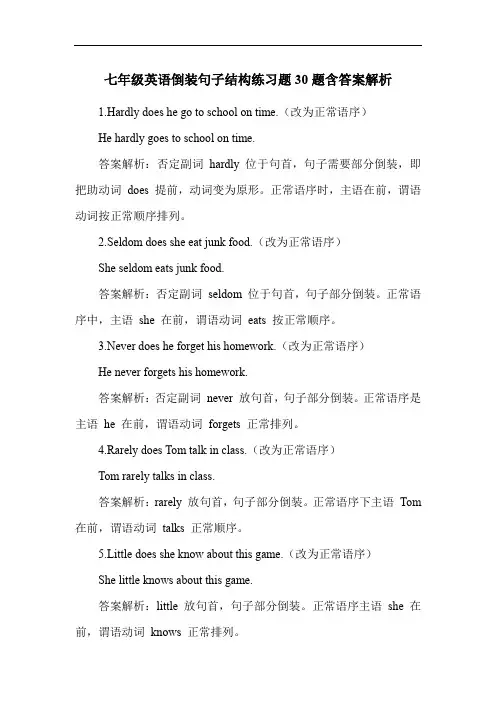
七年级英语倒装句子结构练习题30题含答案解析1.Hardly does he go to school on time.(改为正常语序)He hardly goes to school on time.答案解析:否定副词hardly 位于句首,句子需要部分倒装,即把助动词does 提前,动词变为原形。
正常语序时,主语在前,谓语动词按正常顺序排列。
2.Seldom does she eat junk food.(改为正常语序)She seldom eats junk food.答案解析:否定副词seldom 位于句首,句子部分倒装。
正常语序中,主语she 在前,谓语动词eats 按正常顺序。
3.Never does he forget his homework.(改为正常语序)He never forgets his homework.答案解析:否定副词never 放句首,句子部分倒装。
正常语序是主语he 在前,谓语动词forgets 正常排列。
4.Rarely does Tom talk in class.(改为正常语序)Tom rarely talks in class.答案解析:rarely 放句首,句子部分倒装。
正常语序下主语Tom 在前,谓语动词talks 正常顺序。
5.Little does she know about this game.(改为正常语序)She little knows about this game.答案解析:little 放句首,句子部分倒装。
正常语序主语she 在前,谓语动词knows 正常排列。
6.Scarcely does he finish his work on time.(改为正常语序)He scarcely finishes his work on time.答案解析:scarcely 位于句首,句子部分倒装。
正常语序是主语he 在前,谓语finishes 正常顺序。
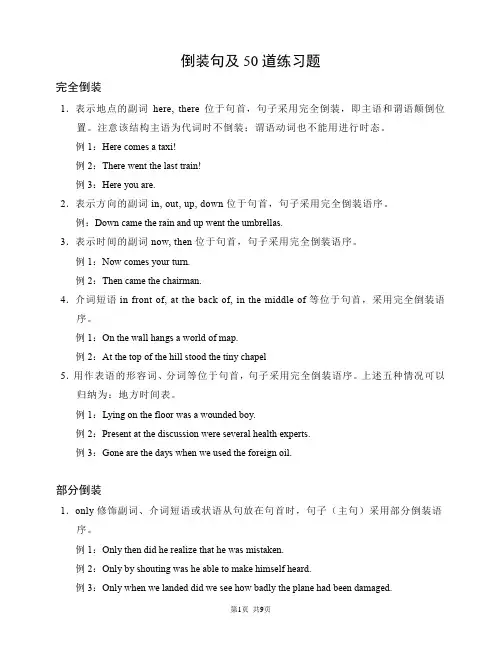
倒装句及50道练习题完全倒装1.表示地点的副词here, there位于句首,句子采用完全倒装,即主语和谓语颠倒位置。
注意该结构主语为代词时不倒装;谓语动词也不能用进行时态。
例1:Here comes a taxi!例2:There went the last train!例3:Here you are.2.表示方向的副词in, out, up, down位于句首,句子采用完全倒装语序。
例:Down came the rain and up went the umbrellas.3.表示时间的副词now, then位于句首,句子采用完全倒装语序。
例1:Now comes your turn.例2:Then came the chairman.4.介词短语in front of, at the back of, in the middle of等位于句首,采用完全倒装语序。
例1:On the wall hangs a world of map.例2:At the top of the hill stood the tiny chapel5.用作表语的形容词、分词等位于句首,句子采用完全倒装语序。
上述五种情况可以归纳为:地方时间表。
例1:Lying on the floor was a wounded boy.例2:Present at the discussion were several health experts.例3:Gone are the days when we used the foreign oil.部分倒装1.only修饰副词、介词短语或状语从句放在句首时,句子(主句)采用部分倒装语序。
例1:Only then did he realize that he was mistaken.例2:Only by shouting was he able to make himself heard.例3:Only when we landed did we see how badly the plane had been damaged.2.so/such….that…句型位于句首时,主句部分采用倒装语序。
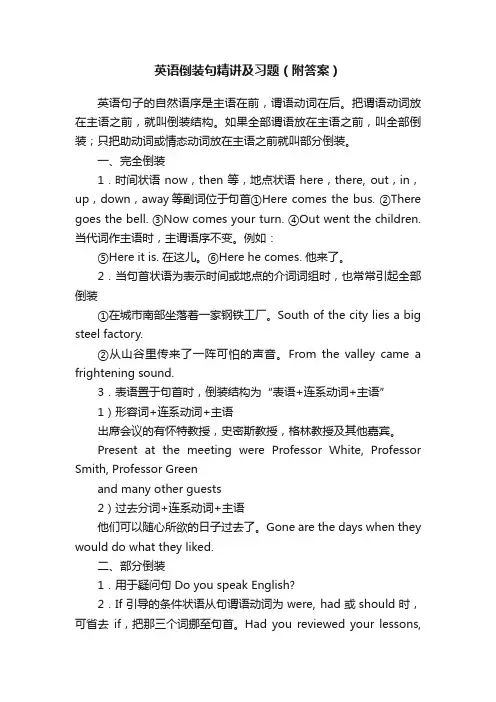
英语倒装句精讲及习题(附答案)英语句子的自然语序是主语在前,谓语动词在后。
把谓语动词放在主语之前,就叫倒装结构。
如果全部谓语放在主语之前,叫全部倒装;只把助动词或情态动词放在主语之前就叫部分倒装。
一、完全倒装1.时间状语now,then等,地点状语here,there, out,in,up,down,away等副词位于句首①Here comes the bus. ②There goes the bell. ③Now comes your turn. ④Out went the children. 当代词作主语时,主谓语序不变。
例如:⑤Here it is. 在这儿。
⑥Here he comes. 他来了。
2.当句首状语为表示时间或地点的介词词组时,也常常引起全部倒装①在城市南部坐落着一家钢铁工厂。
South of the city lies a big steel factory.②从山谷里传来了一阵可怕的声音。
From the valley came a frightening sound.3.表语置于句首时,倒装结构为“表语+连系动词+主语”1)形容词+连系动词+主语出席会议的有怀特教授,史密斯教授,格林教授及其他嘉宾。
Present at the meeting were Professor White, Professor Smith, Professor Greenand many other guests2)过去分词+连系动词+主语他们可以随心所欲的日子过去了。
Gone are the days when they would do what they liked.二、部分倒装1.用于疑问句Do you speak English?2.If引导的条件状语从句谓语动词为were, had或should时,可省去if,把那三个词挪至句首。
Had you reviewed your lessons,you might have passed the examination.Were there enough hands, we should go on with the project.Should I be free tomorrow, I will come to the party.3.用于“形容词(或名词、动词)+as(though)引导的让步状语从句中”①Pretty as she is, she is not clever. ②Try as he could, he might fall again.如果从句的表语是名词,其名词前不加任何冠词。
英语倒装句专项习题及答案分析及分析一、倒装句1.—What language is that guy speaking? I can hardly catch a single word!—. He's from India, so I guess it is Hindi.A. Neither I canB. Neither can IC. So I canD. So can I 【答案】B【分析】【剖析】句意:一一那个人的是什么言?我几乎听不懂一个。
一一我也听不懂,他来自印度,因此我猜那是印地。
So+主 +助,表示的确这样,用于前面是必定的状况,neither+ 主 +助用于前文能否认;So+助 +主,表示⋯⋯也是,用于前文是必定句,Neither+ 助+主,用于前文能否认句。
依据上一句can hardly catch a single word! 和下句 I guess 可知我跟第一句的人一听不懂,表示“我也是”,并且能否认,用Neither can I , B.【点】观察倒装句。
2.— My mother hardly watches any sports shows.—_________A. So do mine.B. So does mine.C. Neither do mine.D. Neither does mine.【答案】D【分析】【剖析】句意:—我几乎不看任何体育目。
—我的也不看。
当 A 做的事, B 和 A 做了相同事, B “So+助 / 情⋯+B”;当 A 没做某事, B 也没做, B 可“Neither/nor+助/ 情⋯+B”。
mine 指的是 my mother ,依据主一致原,可知使用助 does,合句意和境可知 D。
【点】此考倒装构和情形交。
3.—Zhou Ming likes reading English magazines.—_______. It's good for English learning.A. So do IB. So am IC. So I do【答案】A【分析】【剖析】句意:—周明喜英志。
高中英语倒装句练习题30题含答案解析1.Near the house stands a tall tree.At the foot of the mountain lies a small village.On the top of the hill is a big castle.Beside the river runs a narrow path.答案解析:第一题考查完全倒装句。
正常语序为 A tall tree stands near the house. 当表示地点的介词短语位于句首时,句子要完全倒装,即将谓语动词提到主语之前。
选项中只有第一个句子符合完全倒装的结构。
2.Out rushed the children when the bell rang.Away flew the birds when they heard the noise.Down came the rain when they were having a picnic.Up went the prices when the demand increased.答案解析:本题考查完全倒装句。
正常语序为The children rushed out when the bell rang. 当表示方位的副词out、away、down、up 等位于句首时,句子要完全倒装。
选项中只有第一个句子符合完全倒装的结构。
3.There stands a temple on the top of the mountain.On the top of the mountain stands a temple.A temple stands on the top of the mountain.Stand there a temple on the top of the mountain.答案解析:第二、三个句子为正常语序,第一个句子为完全倒装句,将地点状语on the top of the mountain 置于句首,谓语动词stands 提到主语 a temple 之前。
英语倒装句练习题20篇含解析一、倒装句1.–David has made great progress recently. – ______, and ______.A. So he has; so you haveB. So has he; so you haveC. So he has; so have youD. So has he; so have you【答案】 C【解析】【分析】句意为:---戴维最近取得了很大进步。
---确实如此。
你也一样。
“so+be 动词(助动词、情态动词)+主语” 表示前面所叙述的事实也适合于另一个人,“也”之意。
“so+主语+be动词(助动词、情态动词)”表示肯定前面所叙述的是事实,“确实如此”之意。
结合语境可知应选C。
【点评】考查固定句型的用法。
2.一 I didn't watch the football match on TV yesterday.一 . I got home too late to watch it.A. So did IB. Neither did IC. So I didD. Neither I did【答案】 B【解析】【分析】neither/nor+助动词+主语,译为“某人(物)也不……”,如果上句是否定句,那么下句就是也不是这种情况;so+助动词+主语,意为“某人(物)也是……”如果上句是肯定句,那么下句就是也是这种情况。
用于这种结构的主语是不同的人,如果是上下的两句的主语是同一个人,则用半倒装结构,so+主语+助动词,表示“某人的确是这样”。
句意:—我没看昨天的聊天节目,—我也没看,我到家太晚而没有看。
结合句意,故选B。
3.—He's never been late for school.—________________.A. So have IB. So am IC. Neither have ID. Nor am I【答案】 C【解析】【分析】句意:—他从来没有上学迟到过。
英语语法专题倒装讲义和练习及答案英语的大体语序是“主语+谓语”,若是将谓语的一部份或全数放在主语之前,这种语序叫倒装。
倒装既是一种语法手腕,也是一种修辞手腕,用于表示必然的句子结构或强调某一句子成份。
倒转句的考查主要从以下几个方面入手:1)含有否定意味的词置于句首,部份倒装;2)only+状语/状语从句置于句首,部份倒装;3)so/such…that句型中,so+形容词/副词提前,部份倒装;4)表示方位的副词或介词短语放在句首,要完全倒装。
一.倒装的原因A.语法倒装由于语法结构的需要,将谓语的全数或一部份移到主语之前。
1.一般疑问句当咱们把一个肯定句转变成疑问句时,常把肯定句中的助动词或情态动词放在句首。
这种助动词或情态动词包括:be,have,can,do,shall,will,may,must,dare,need,ought或used 等。
He will do it. ——Will he do it?他会做这件事吗?This is my mobile phone number. ——Is this your mobile phone number?这是你的电话号码吗?提示:若是肯定句中没有助动词或情态动词时,咱们可以在句首用do 的某种形式,以组成倒装语序。
Jack likes to eat fish. 杰克喜欢吃鱼。
——Does Jack like to eat fish 杰克喜欢吃鱼吗?2.特殊疑问句特殊疑问句的组成:特殊疑问词+ 一般疑问句What does he like to eat 他喜欢吃什么?When will they go to the Great Wall 他们何时去长城?Where did you go last night 昨晚你去哪里了?Who is not coming to dinner tonight 今晚谁不来用饭?3. 反意问句在反意问句中,用一般疑问句的形式,前后两分句的主语,人称要一致。
高考英语倒装句练习题30题含答案解析1.Never have I seen such a beautiful sunset.Not only have I read this book, but also I have recommended it to my friends.Hardly had I arrived home when it started to rain.Seldom does he go to the movies.Little did she know what was going to happen.Nowhere can you find a better place to relax.At no time should we give up.By no means is he a bad person.In no way can we accept this proposal.Under no circumstances will I betray my country.答案解析:1.以否定副词never 开头,句子要用部分倒装,把助动词have 提到主语I 前面。
在高考中,这种倒装句常出现在阅读理解和写作中,以增加句子的表现力。
本题中其他选项没有倒装,不符合语法要求。
2.以not only...but also...连接的句子,当not only 位于句首时,前半句要用部分倒装,把助动词have 提到主语I 前面。
3.以hardly...when...引导的句子,hardly 位于句首时,句子要用部分倒装,把助动词had 提到主语I 前面。
4.以seldom 开头,句子要用部分倒装,把助动词does 提到主语he 前面。
5.以little 开头,句子要用部分倒装,把助动词did 提到主语she 前面。
6.以nowhere 开头,句子要用部分倒装,把情态动词can 提到主语you 前面。
倒装句知识点归纳及练习(附答案)主语和谓语有两种顺序:一是主语在前,叫自然语序。
反之,如果谓语在主语前就是倒装语序,又分全部倒装和部分倒装。
全部倒装是把全部谓语放在主语之前,部分倒装是把助动词或情态动词放在主语之前。
一、全部倒装1.there be 句型:可以用在这类句型中的动词除be外,还可用live,happen,exist,remain,stand等等作这类句型的谓语。
如:There are many students in the classroom.教室里有许多学生。
Long ,long ago there lived a king who loved horses very much.很久很久以前,有一位国王,他非常喜欢马。
There happened to be nobody in the bedroom when the fire broke out.起火的时候,碰巧房间里面没有人。
2.Here/There/Now/then+vi.(常为come,go)+主语(必须是名词)Here comes Mary. → I can see Mary coming.玛丽来了。
There goes the bell. 铃响了。
→I can hear the bell ringing.Here comes the bus.汽车来了。
There he comes.他来了。
Then came a new difficulty. 然后产生了一个新的困难。
Then followed eight years of the Anti Japanese War.接着是八年抗战。
这种句型不能用现在进行时。
here句中也可用系动词。
如:Here are some story book s I want. →Here is what you asked for,or you are looking for.这就是我要的故事书。
一、全部倒装全部倒装是只将句子中的谓语动词全部置于主语之前。
此结构通常只用与一般现在时和一般过去时。
常见的结构有:1) here, there, now, then, thus 等副词置于句首 , 谓语动词常用 be, come, go, lie, run 。
There goes the bell.Then came the chairman.Here is your letter.2) 表示运动方向的副词或地点状语置于句首,谓语表示运动的动词。
Out rushed a missile from under the bomber.Ahead sat an old woman.注意:上述全部倒装的句型结构的主语必须是名词,如果主语是人称代词则不能完全倒装。
Here he comes. Away they went.二、部分倒装部分倒装是指将谓语的一部分如助动词或情态倒装至主语之前。
如果句中的谓语没有助动词或情态动词,则需添加助动词 do, does 或 did ,并将其置于主语之前。
1) 句首为否定或半否定的词语,如 no, not, never, seldom, little, hardly, at no time, in no way, not until... 等。
Never have I seen such a performance.Nowhere will you find the answer to this question.Not until the child fell asleep did the mother leave the room.当 Not until 引出主从复合句,主句倒装,从句不倒装。
注意:如否定词不在句首不倒装。
I have never seen such a performance.The mother didn't leave the room until the child fell asleep.典型例题1) Why can't I smoke here?At no time___ in the meeting-roomA. is smoking permittedB. smoking is permittedC. smoking is it permittedD. does smoking permit答案 A. 这是一个倒装问题。
当否定词语置于句首以表示强调时,其句中的主谓须用倒装结构。
这些否定词包括 no, little, hardly, seldom, never, not only, not until 等。
本题的正常语序是Smoking is permitted in the meeting-room at no time.2 ) Not until the early years of the 19th century ___ what heat is.A. man did knowB. man knowC. didn't man knowD. did man know答案 D. 看到 Not until... 的句型,我们知道为一倒装句,答案在 C , D 中选一个。
改写为正常语序为, Man did not know what heat is until the early years of the 19th. 现在将 not 提前,后面就不能再用否定了 , 否则意思就变了。
(1)以否定词开头作部分倒装如 Not only...but also, Hardly/Scarcely...when, No sooner... thanNot only did he refuse the gift, he also severely criticized the sender.Hardly had she gone out when a student came to visit her.No sooner had she gone out than a student came to visit her.典型例题No sooner___ than it began to rain heavily.A. the game beganB. has the game begunC. did the game beginD. had the game begun答案 D. 以具有否定意义的副词放在句首时,一般采用倒装句 ( 谓语前置 ) 。
这类表示否定意义的词有 never, seldom, scarcely, little, few, not, hardly, 以及 not only...but (also), no sooner...than, hardly... when scarcely... when 等等。
注意:只有当 Not only... but also 连接两个分句时,才在第一个分句用倒装结构。
如果置于句首的 Not only... but also 仅连接两个并列词语,不可用倒装结构。
Not only you but also I am fond of music.(2)so, neither, nor 作部分倒装表示 " 也 " 、 " 也不 " 的句子要部分倒装。
Tom can speak French. So can Jack.If you won't go, neither will I.典型例题---Do you know Jim quarrelled with his brother?---I don't know, _____.A. nor don't I careB. nor do I careC. I don't care neitherD. I don't care also答案: B. nor 为增补意思 " 也不关心 " ,因此句子应倒装。
A 错在用 don't 再次否定, C neither 用法不对且缺乏连词。
D 缺乏连词。
注意:当 so 引出的句子用以对上文内容加以证实或肯定时,不可用倒装结构。
意为 " 的确如此 " 。
Tom asked me to go to play football and so I did.---It's raining hard. ---So it is.(3)only 在句首要倒装的情况Only in this way, can you learn English well.Only after being asked three times did he come to the meeting.如果句子为主从复合句,则主句倒装,从句不倒装Only when he is seriously ill, does he ever stay in bed(4)as, though 引导的倒装句as / though 引导的让步从句必须将表语或状语提前(形容词 , 副词 , 分词 , 实义动词提前)。
注意 :1) 句首名词不能带任何冠词。
2) 句首是实义动词 , 其他助动词放在主语后。
如果实义动词有宾语和状语 , 随实义动词一起放在主语之前。
Try hard as he will, he never seems able to do the work satisfactorily.注意 : 让步状语从句中,有 though , although 时,后面的主句不能有 but ,但是 though 和 yet 可连用。
(5)其他部分倒装1)so... that 句型中的 so 位于句首时,需倒装。
So frightened was he that he did not dare to move an inch.2) 在某些表示祝愿的句型中:May you all be happy.3) 在虚拟语气条件句中从句谓语动词有 were, had, should 等词,可将 if 省略,把 were, had, should 移到主语之前,采取部分倒装。
Were I you, I would try it again.典型例题:1 ) Not until the early years of the 19th century___ what heat isA. man did knowB. man knewC. didn't man knowD. did man know答案为 D. 否定词 Not 在句首,要求用部分倒装的句子结构。
2 ) Not until I began to work ___ how much time I had wasted.A. didn't I realizeB. did I realizeC. I didn't realizeD. I realize3) Do you know Tom bought a new car?I don't know, ___.A. nor don't I careB. nor do I careC. I don't care neitherD. I don't care also解析:答案为 B. 句中的 nor 引出部分倒装结构,表示 " 也不 " 。
由 so, neither, nor 引导的倒装句,表示前一情况的重复出现。
其中 , so 用于肯定句 , 而 neither, nor 用在否定句中。
(6)虚拟条件句的倒装虚拟条件句的从句部分如果含有 were, should, 或 had, 可将 if 省略,再把 were, should 或 had 移到从句句首,实行倒装。
Were they here now, they could help us.=If they were here now, they could help us.Had you come earlier, you would have met him=If you had come earlier, you would have met him.Should it rain, the crops would be saved.=Were it to rain, the crops would be saved.注意 : 在虚拟语气的从句中,动词 'be' 的过去时态一律用 "were" ,不用 was ,即在从句中 be 用 were 代替。